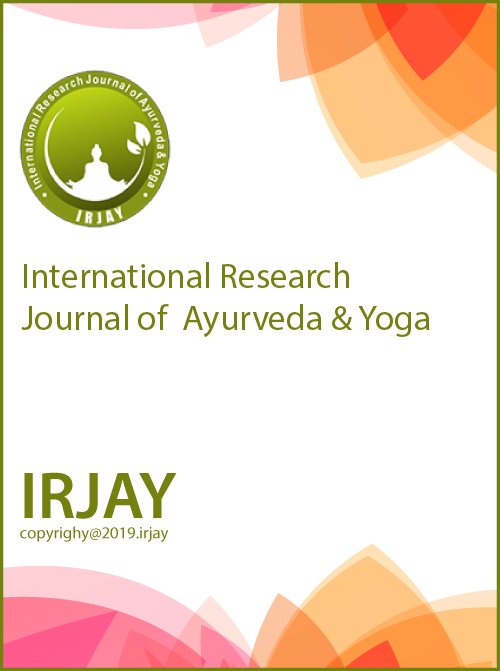Concept of Aam in Ayurveda and its Importance in Treating Diseases
DOI:
https://doi.org/10.48165/Keywords:
Aam, Mandagni, Sama, Nirama, ApatarpanAbstract
Aam is the Apakva Ahara Rasa formed due to the action of Mandagni on ingested food. It is the root cause of many diseases. Due to its distinct qualities it can obstruct the Srotas. Hence the Doshas start accumulating at the site of obstruction and cause diseases. Depending upon its association, diseases can be divided into two groups - Sama and Nirama. In Ayurveda various Acharyas have described about qualities, features and treatment modalities of Aam. It is very important to distinguish between Sama and Nirama Avastha of the body before treating any disease. Because, in the presence of Aam and its causative factor Mandagni, it is not possible to digest Dosha, Ahara and even Ousadh. This leads to formation of more Aam and further increases the severity of the disease. Therefore in Sama diseases, Aam pacifying treatment, such as Apatarpan, has to be applied first and only after attaining Nirama Avastha, other disease specific treatment should be applied.
Downloads
References
Shastri K, Susruta Samhita, edited with Ayurveda Tattva Sandipika-Hindi commentary Sutrastahana 1/36 Chaukhambha Sanskrit Sansthan, Varanasi, 2012.
Shastri KN, Charaka Samhita, Part-II (Vidyotini Hindi commentary). editors. 1st ed. Chikistasthana 15/5 Varanasi: Chaukhambha Bharati Academy; 1998.
Gupta A, Ashtanga Hridaya by Vaghbhatta : Hindi commentary Sutrasthana 13/25, Chaukhambha Prakashan, Varanasi, 2020.
Gupta A, Ashtanga Hridaya by Vaghbhatta : Hindi commentary Sutrasthana 13/27, Chaukhambha Prakashan, Varanasi, 2020.
Shastri KN, Charaka Samhita, Part-II (Vidyotini Hindi commentary). editors. 1st ed. Chikistasthana 15/38 Varanasi: Chaukhambha Bharati Academy; 1998
Shastri KN, Charaka Samhita, Part-II (Vidyotini Hindi commentary). editors. 1st ed. Chikistasthana 15/39 Varanasi: Chaukhambha Bharati Academy; 1998.
Shastri KN, Charaka Samhita, Part-II (Vidyotini Hindi commentary). editors. 1st ed. Chikistasthana 15/13-15 Varanasi: Chaukhambha Bharati Academy; 1998
Shastri KN, Charaka Samhita, Part-II (Vidyotini Hindi commentary). editors. 1st ed. Chikistasthana 15/3-4 Varanasi: Chaukhambha Bharati Academy; 1998.
Shastri KN, Charaka Samhita, Part-II (Vidyotini Hindi commentary). editors. 1st ed. Chikistasthana 15/51 Varanasi: Chaukhambha Bharati Academy; 1998
Gupta A, Ashtanga Hridaya by Vaghbhatta : Hindi commentary, Nidansthana 12/1Chaukhambha Prakashan, Varanasi, 2020.
Pandey AK, Ayurvediya Roga Nidana (Part-I) Chapter-9, Chaukhambha Sanskrit Sansthana, 2021.pp.55.
Shastri KN, Charaka Samhita, Part-II (Vidyotini Hindi commentary). editors. 1st ed. Vimansthana 2/8-9. Varanasi: Chaukhambha Bharati Academy; 1998.
Gupta A, Ashtanga Hridaya by Vaghbhatta : Hindi commentary, Nidansthana 12/1Chaukhambha Prakashan, Varanasi, 2020.
Shastri KN, Charaka Samhita, Part-II (Vidyotini Hindi commentary). editors. 1st ed. Vimansthana 2/10. Varanasi: Chaukhambha Bharati Academy; 1998.
Gupta A, Ashtanga Hridaya by Vaghbhatta : Hindi commentary, Sutrasthana 13/27, Chaukhambha Prakashan, Varanasi, 2020.
Gupta A, Ashtanga Hridaya by Vaghbhatta : Hindi commentary, Sutrasthana 13/24, Chaukhambha Prakashan, Varanasi, 2020.
Shastri KN, Charaka Samhita, Part-II (Vidyotini Hindi commentary). editors. 1st ed. Vimansthana 2/13. Varanasi: Chaukhambha Bharati Academy; 1998.
Shastri KN, Charaka Samhita, Part-II (Vidyotini Hindi commentary). editors. 1st ed. Vimansthana 3/43-44. Varanasi: Chaukhambha Bharati Academy; 1998.
Shastri KN, Charaka Samhita, Part-II (Vidyotini Hindi commentary). editors. 1st ed. Vimansthana 2/14. Varanasi: Chaukhambha Bharati Academy; 1998.
Shastri KN, Charaka Samhita, Part-II (Vidyotini Hindi commentary). editors. 1st ed. Chikistasthana 3/133-135.. Varanasi: Chaukhambha Bharati Academy; 1998.
Gupta A, Ashtanga Hridaya by Vaghbhatta : Hindi commentary, Chikistasthana 1/1, Chaukhambha Prakashan, Varanasi, 2020.
Shastri AD, Susruta Samhita, edited with Ayurveda Tattva Sandipika-Hindi commentary Uttaratantra 40/16,34Chaukhambha Sanskrit Sansthan, Varanasi, 2012.
Shastri KN, Charaka Samhita, Part-II (Vidyotini Hindi commentary). editors. 1st ed. Chikistasthana 12/17. Varanasi: Chaukhambha Bharati Academy; 1998.
Shastri KN, Charaka Samhita, Part-II (Vidyotini Hindi commentary). editors. 1st ed. Chikistasthana 15/73-74. Varanasi: Chaukhambha Bharati Academy; 1998.
Shastri AD, Susruta Samhita, edited with Ayurveda Tattva Sandipika-Hindi commentary Uttaratantra 48/30 Chaukhambha Sanskrit Sansthan, Varanasi, 2012.
Gupta A, Ashtanga Hridaya by Vaghbhatta : Hindi commentary, Chikistasthana 6/75, Chaukhambha Prakashan, Varanasi, 2020.
Gupta A, Ashtanga Hridaya by Vaghbhatta : Hindi commentary, Chikistasthana 22/50, Chaukhambha Prakashan, Varanasi, 2020.
Shastri KN, Charaka Samhita, Part-II (Vidyotini Hindi commentary). editors. 1st ed. Chikistasthana 27/25. Varanasi: Chaukhambha Bharati Academy; 1998.
Shastri AD, Susruta Samhita, edited with Ayurveda Tattva Sandipika-Hindi commentary Uttaratantra 124/126 Chaukhambha Sanskrit Sansthan, Varanasi, 2012.
Shastri KN, Charaka Samhita, Part-II (Vidyotini Hindi commentary). editors. 1st ed. Chikistasthana 15/44. Varanasi: Chaukhambha Bharati Academy; 1998.
Shastri AD, Susruta Samhita, edited with Ayurveda Tattva Sandipika-Hindi commentary Sutrastahana 24/19 Chaukhambha Sanskrit Sansthan, Varanasi, 2012

